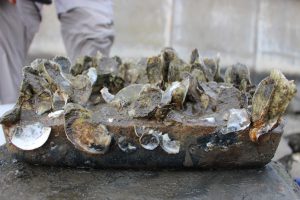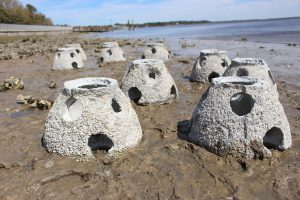As Florida braces for more storms and hurricanes battering our coasts, “living shorelines” are a term you might begin to hear more. They are a method utilized to protect and stabilize shorelines from erosion using natural materials such as oyster shells, rock, sand and native vegetation.
In Northeast Florida along the Nassau River, UF/IFAS Extension and community volunteers are working towards improving the resilience of their shoreline by building a demonstration living shoreline. Located at Goffinsville Park, the shoreline there has dealt with high rates of erosion and a few years ago installed an expansive sea wall to halt the erosion. This project is showcasing an ‘amended seawall’ living shoreline providing benefits to fish and wildlife. It also provides a natural buffer for the manmade structure with the goal of reducing the scouring at the base and washout at the top its currently experiencing.
The shoreline demonstrates four different materials. Three of them are biodegradable, offering plastic free options for natural resource managers or homeowners to determine what might work best for their environmental conditions and goals.
Oyster Reef Bags
The first material deployed were oyster reef bags constructed by volunteers. They are non-biodegradable plastic mesh bags filled with cleaned oyster cultch (oyster shells). The bags are placed and piled on top of each other to reduce wave energy to the shoreline. This method is a low cost option ideal for a smaller shoreline.


Community Oyster Reef Enhancement (CORE) modules
Community Oyster Reef Enhancement (CORE) modules were the second material deployed. Created by Dr. Todd Osborne’s Laboratory at the UF Whitney Laboratory for Marine Biosciences these were also built by volunteers. They are partially biodegradable plastic-free structures made of concrete, oyster shell, wood chips, and other organic materials providing a wave break.

Oyster Reef Balls
Right before coronavirus changed the world we live in, volunteers and students from the University of North Florida (UNF) deployed the third material. Generously donated by UNF’s Environmental Center, the oyster reefs balls are built with a special cement mix that helps oyster recruitment. These ones look similar to the large scale artificial reef ones you may see offshore Northeast Florida but are smaller in size to accommodate nearshore habitats.

Reef Prisms
The last material was scheduled to be deployed this past Spring but coronavirus had other plans. We’re looking for volunteers interested in helping with the next deployment of Reef Prisms. Reef prisms can be formed into many different shapes ideal for the variability found in shorelines. They are made of jute and cement, making them biodegradable.

For more information about other living shoreline projects in your area, check out Florida’s Living Shorelines. To find more specifics about the Goffinsville Park Demonstration Living Shoreline, click here.
 0
0
